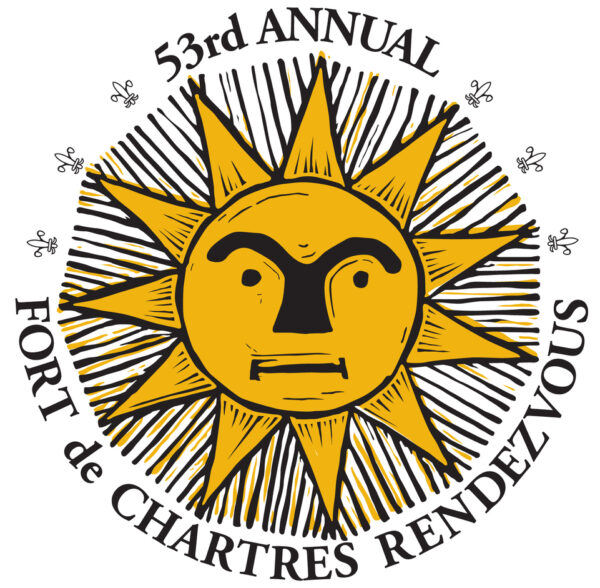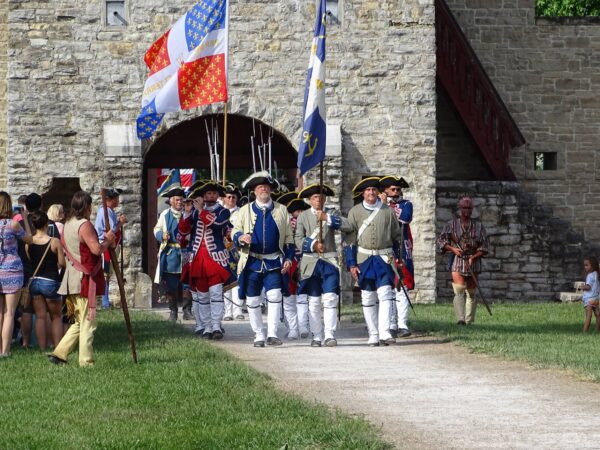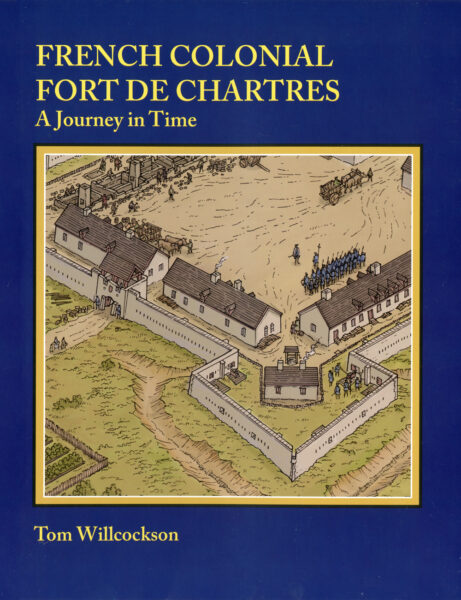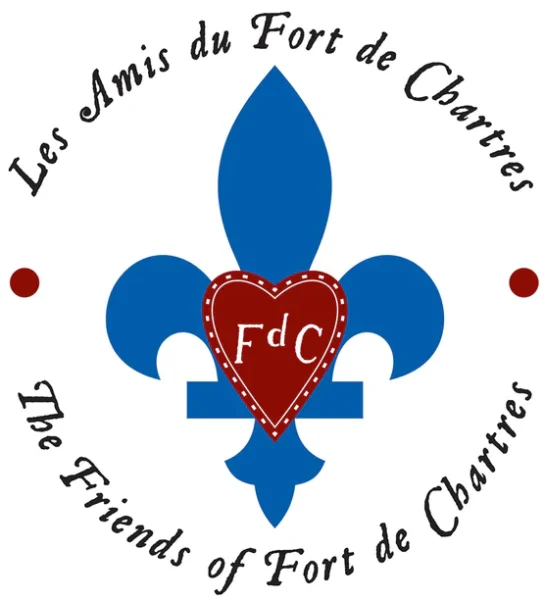Q&A with Jennifer Duensing, president, Les Amis du Fort de Chartres
The Project…
General Operating Support
Location: Prairie du Rocher, Illinois
Les Amis du Fort de Chartres received funds in November 2022 to support the organization’s operations.
The Organization…
The mission of Les Amis du Fort de Chartres is to preserve, protect, and interpret the physical structural and cultural heritage of Fort de Chartres in the 1700s. Inside the fort are the restored powder magazine, believed to be the oldest building in Illinois, two reconstructed stone buildings, and the exposed foundations of other buildings. The powder magazine is stocked with reproduction barrels and barrel racks. A combination museum and office building, built in 1928 on the foundation of an original fort building, houses exhibits depicting the history of Fort de Chartres and the Illinois Country.
Follow Les Amis du Fort de Chartres: Website | Facebook | Attend an Event
Upcoming Event:
 The 53rd Annual Fort de Chartres Rendezvous
The 53rd Annual Fort de Chartres Rendezvous
Saturday | June 3, 2023 | 10:00 a.m. – 5:00 p.m.
Sunday | June 4, 2023 | 10:00 a.m. – 5:00 p.m.
The two-day popular annual Rendezvous, usually held the first weekend in June, features shooting competitions, military drills, dancing, music, food, and traders of eighteenth-century-style goods.
The event is open and free to general public with special event parking for this event just $5 a car. Donations welcomed.
*Featured Image: Fort de Chartres front entrance | Photo by Kelly Adams
The Q&A…
Q: How do you see the arts/culture/humanities as being essential?

Jennifer Duensing: I think the history of our mission is highly connected to the cultural avenues of the people who formed this area and the history of this area, and especially the arts because the things they did and taught are the very things we are trying to teach today. You can see it in our educational programs and in the families where the skills were passed down. The arts are such an important part of our region; at our events, people are actually demonstrating blacksmithing, quillwork, weaving (with a series of knots, not on a spinning wheel), pewter work, baking, singing, shooting, hunting, pottery. The public really enjoys it. I think they get a sense of history; we hear things like ‘my grandparent or great-grandparent used to do that.’ Some are lost art forms. If there is no market or need or way to show these art ways, they’re going to disappear. So our mission of showing these and teaching them is so important; if not, they’ll be lost.
Q: What is the most important thing people should know about your work?
Jennifer Duensing:
The people who do the teaching are actually from all over the country, and many of them learned the art form they teach from an ancestor. It was passed down to them. From the blacksmiths to the coopers who make the barrels. And others are just history enthusiasts, who saw this done, and it sparked an interest. This time is the 53rd Rendezvous, and we have some demonstrators who have been coming since the beginning; now their children are doing it. One of the coolest things is to see little kids running around in 18th-century clothing! We love that.
We’re also unique due to our location. One of the only reconstructed stone forts in the U.S. Our town is 300 years old. It has the oldest building in Illinois, the powder magazine, which is 300 years old. The whole area here was developed due to Fort du Chartres. We’re also near Kaskaskia, which is where Illinois began. Our support group not only does the educational programs, but we do the fundraising for the site itself – for the repairs, say, as well as the tourism promotion. We do all the above for the site as a whole package. There are many elements involved in what we do. And the site, which is in the middle of nowhere, brings in more than 50,000 people a year.
Q: How did you arrive at doing what you do?
Jennifer Duensing: I grew up in this area, so as a child and young adult visited the Fort all the time. My husband is a reenactor, and his dad was the site superintendent, so he basically grew up at the Fort. Ten years ago I started volunteering at the garden. Carol Kuntz and I became good friends, and there was a need for a support group. So in 2015 we reformed and revitalized the support group.
Those of us who live here tend to take the Fort for granted; it’s always been here. We don’t realize until we go out into the world what we have here. We have this big stone fort, yet there are people nearby, in Waterloo, who have never been to see it. It’s humbling when people come from out of town or across the state and remind us of the importance of what we have here.
Q: Who makes your work possible?
Jennifer Duensing: We have a wide array of collaborative partners and sponsors; we wouldn’t be anywhere without them. Illinois Humanities is a huge part of that. We also have huge support from our local legislators and our community. And then the volunteers from across the country. We are completely financed through donations, grants, and sponsorships. If we didn’t have these, we couldn’t do anything. We have support from the French Colonial Historical Society, the Colonial Dames of America, and the General Society of Colonial Wars. And a lot of support from local businesses in general.

Jennifer Duensing’s Suggested Reading:
French Colonial Fort de Chartres: A Journey in Time
This book was created with “Forgotten Illinois” grant support from Illinois Humanities.
This Les Amis educational project is a line-art publication depicting the pre-statehood years of 1755-1756 in and around Fort de Chartres. A Journey in Time is a line-art, one-color publication, created by award-winning artist Tom Willcockson and published by Les Amis du Fort de Chartres. Tom is the artist of the current interactive pamphlet available at the fort and his art is featured in two other publications: Twelve Moons: A Year with the Sauk and Meskwaki, 1817-1818 and Passage to Chicago: A Journey on the Illinois & Michigan Canal in the Year 1860. Both publications won the Illinois Association of Museums’ Superior Achievement Award.
The style of this publication featuring Fort de Chartres’ mid-eighteenth-century history is unique to other currently published books about Fort de Chartres, presenting a great visual perspective for young adults and the general public.
About The Illinois Humanities Grantee Partner Spotlight
Illinois Humanities highlights the work of our Community Grants program partners through our “Grantee Spotlight.” It shines the light on our grantee partner’s work, offering details about the organization and the funded project, as well as a Q&A with a team member at the organization. More: ILHumanities.org/Spotlight
About Illinois Humanities
Illinois Humanities, the Illinois affiliate of the National Endowment for the Humanities, is a statewide nonprofit organization that activates the humanities through free public programs, grants, and educational opportunities that foster reflection, spark conversation, build community and strengthen civic engagement. We provide free, high-quality humanities experiences throughout Illinois, particularly for communities of color, individuals living on low incomes, counties and towns in rural areas, small arts and cultural organizations, and communities highly impacted by mass incarceration. Founded in 1974, Illinois Humanities is supported by state, federal, and private funds.
Learn more at ilhumanities.org and on Facebook, Twitter, Instagram, and LinkedIn @ILHumanities.
